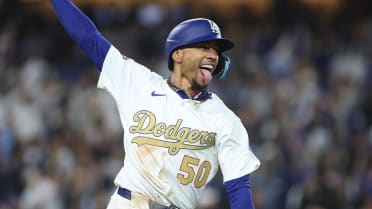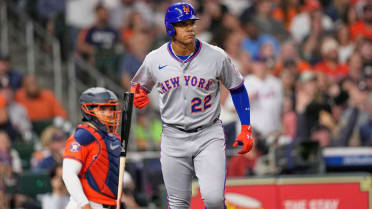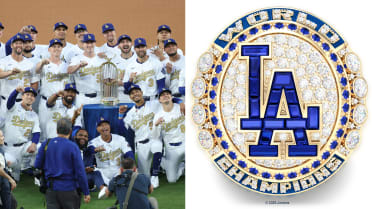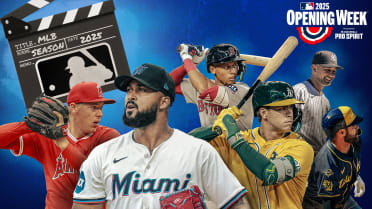As the trade market starts to take shape over the next month, you’ll undoubtedly hear plenty of speculation surrounding Max Scherzer, Trevor Story, Nelson Cruz, Matthew Boyd, Joey Gallo and Mitch Haniger.
You will also likely start to hear some chatter involving the three veterans below, which would have seemed surprising a couple months ago. None was expected to be a coveted trade target when this season began, but all three have put together superb rebound campaigns while playing for clubs that might sell.
These under-the-radar names -- one starter, one position player and one reliever -- could end up being three of the best players available before the July 30 Deadline.
Kyle Gibson, RHP, Rangers
What he’s doing
Gibson has made a remarkable turnaround after a dreadful Opening Day start against the Royals in which he got only one out and allowed five runs. Over his past 10 starts, Gibson has posted a 1.38 ERA across 65 1/3 innings. The righty had a brief IL stint due to a right groin strain, but he returned to blank the red-hot Rays over 5 1/3 innings Friday.
This is uncharted territory for Gibson, who’s had an up and down career that resulted in a 4.57 ERA over his first eight seasons. After pitching through ulcerative colitis and finishing with a 4.84 ERA in 2019, Gibson left the Twins to sign a three-year, $28 million contract with the Rangers. He had a 5.35 ERA in his first season with Texas.
Gibson became the Rangers’ No. 1 starter when the club traded Lance Lynn in the offseason, and he’s no longer just a nominal ace. With the Rangers playing sub-.400 ball so far, the 33-year-old figures to be available at the Trade Deadline, his value boosted by his reasonable $7 million base salary in 2022. The Rangers might opt to hold onto him for another year, but their experience with Mike Minor could influence their actions. Texas didn’t sell high on Minor during his career year in 2019, and after the lefty regressed in ‘20, the club dealt him to the A’s for two Minor Leaguers, neither of whom ranks among the team’s Top 30 prospects.
How he’s doing it
To start, Gibson’s stuff has been nastier this season. His sinker, slider and changeup are all moving more than they did last year, and he's held batters to a collective .197 average and a .290 slugging percentage with those three pitch types, down from .291 and .473 in 2020.
Gibson’s location also has improved. The righty has one of the highest edge rates (pitches thrown to the edges of the strike zone) in the Majors this season at 46.5%, up from 42.8% last year. This development not only has allowed Gibson to take advantage of the Rangers’ excellent framing -- they have two of the best framers in the game in Jonah Heim and Jose Trevino -- but also has helped him keep opposing hitters from squaring up the ball as much.
Gibson isn’t exceptional at missing bats or preventing hard-hit balls (95+ mph exit velocity), but a lot of the hard contact he allows is outside the launch angle sweet-spot zone of 8-32 degrees. Gibson’s sweet-spot rate (27%) has dropped more than six percentage points from last year and is MLB's seventh-lowest mark in 2021 (min. 100 batted balls). In turn, he’s been able to minimize barrels, batted balls with the optimal combination of exit velocity and launch angle, typically resulting in extra-base hits and homers.
Lowest barrel rate, 2021
Min. 100 batted balls allowed
Alex Cobb (LAA): 2.9%
Brady Singer (KC): 3.4%
Sandy Alcantara (MIA): 3.7%
Jon Gray (COL): 3.7%
Kyle Gibson (TEX): 3.8%
Best fits: Cardinals, Blue Jays, Red Sox, A’s, Braves, Cubs
Adam Frazier, 2B, Pirates
What he’s doing
Coming off the worst season of his career in all three slash-stat categories, Frazier leads MLB in hits (76) and doubles (20), ranks fourth in batting average (.332) and is tied for ninth in on-base percentage (.394).
Amazingly, Frazier has hit safely in 32 of his past 35 games, racking up 50 knocks in that span.
With the Pirates likely staring at a long-term rebuild, it would make sense to shop Frazier for future assets. The 29-year-old has one year of arbitration eligibility remaining before he can become a free agent. A left-handed hitter, Frazier has primarily played second base in his career, but he also has experience in the outfield, mostly in left.
How he’s doing it
Frazier’s success is driven by his outstanding ability to get his bat on the ball. He has the fifth-lowest strikeout rate (10.8%) among qualifying hitters, and only five players have a lower whiff rate (misses / swings).
Lowest whiff rate, 2021
Min. 200 swings
Nick Madrigal (CWS): 8.3%
David Fletcher (LAA): 9.2%
Michael Brantley (HOU): 10.9%
Kevin Newman (PIT): 11.7%
Luis Arraez (MIN): 12.0%
Adam Frazier (PIT): 12.1%
Frazier has a limited offensive ceiling due to his lack of pop -- his barrel rate and hard-hit rate are both among the lowest in MLB, and his expected slugging percentage is below .400 -- but that doesn’t mean he can’t help a contender.
Frazier has a high line drive rate, and he hits a lot of flares (high-angled balls with low exit velocities) and burners (hard-hit grounders). Flares/burners may not be good for producing extra-base hits, but they have generated a .650 average around the Majors this season. Add it all up and Frazier’s .291 expected batting average, which is based on quality of contact and strikeouts, ranks in the 88th percentile.
He’d be a great fit with a strikeout-prone club that is looking for more balance in its lineup.
Best fits: Yankees, Blue Jays, Indians, Cubs, Red Sox, Rays, Giants, Braves, Mets
Daniel Hudson, RHP, Nationals
What he’s doing
Hudson’s final line in the abbreviated 2020 season made his performance look worse than it was. The right-hander threw a scoreless outing in 15 of his 22 appearances, but he gave up six homers and 14 earned runs in the other six en route to a 6.10 ERA on the year.
The 34-year-old has avoided those types of blow-ups this year, recording a 2.38 ERA while slashing his walk and home run rates and posting a career-high 36.8% strikeout rate.
Hudson was a crucial Trade Deadline acquisition for the eventual World Series-champion Nationals in 2019, and the postseason experience he gained that year is an added bonus. If the Nats continue to struggle, impending free agents such as Hudson could be put on the trade block.
How he’s doing it
Hudson has used his four-seam fastball and slider almost exclusively this season, and the two pitches have made for a potent combination.
The righty has the highest average four-seam velocity of his career at 97.1 mph, and his slider has returned to form after he yielded a .294 average and .647 slugging percentage with the pitch last season.
Hudson has gotten a whiff on 55% of the swings he’s generated on sliders in 2021, the 13th-highest figure in the Majors (min. 25 swings on sliders), and opponents have gone 2-for-19 (.105) with 12 strikeouts against his slider.
Overall, Hudson’s whiff rate is 34.6%, which ranks in the 89th percentile. It not only represents a personal best for Hudson but is almost 12 percentage points better than his mark from two seasons ago.
As the Rays showed during last year's run to the World Series, teams can never have enough high-octane, bat-missing bullpen arms in the playoffs. The list of clubs with interest in Hudson will likely be long if he's made available.
Best fits: Braves, Giants, A’s, Cardinals, Astros, Rays, Blue Jays, Padres
Thomas Harrigan is a reporter for MLB.com.




